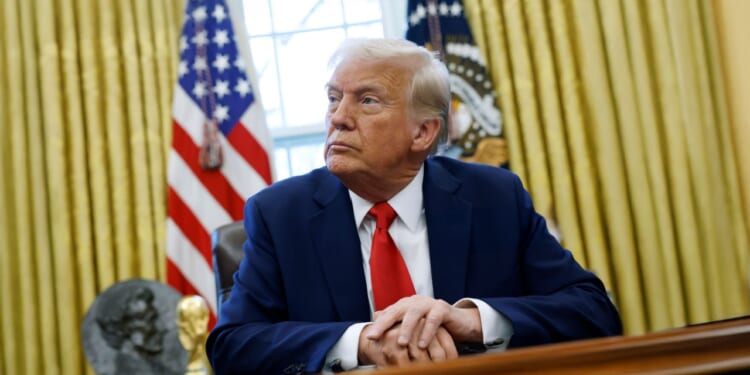President Trump risks repeating the mistakes of the War on Terror with his declaration of war on Venezuelan drug cartels.
Last week, President Trump declared in a written notice to several congressional committees that the United States is in an “armed conflict” with Latin American drug cartels. This declaration appears to be an after-the-fact rationale for multiple US attacks since the beginning of September on boats in the Caribbean that the administration alleges were running drugs. The timing and ex post facto nature of the administration’s statement, however, are far from the only issues that the declaration raises.
For one thing, the Constitution (in Article I, Section 8) gives the power to declare war to Congress, not the president. Although traditional declarations of war have fallen into disuse since World War II, Congress has employed resolutions in other formats to authorize the use of military force. Even woebegone wars such as the ones in Vietnam and Iraq rested on congressional authorizations, notwithstanding how the enactment of war resolutions in those two cases was rushed and ill-informed. The Trump administration has received no congressional authorization for the use of military force against boats in the Caribbean.
Moreover, the drug cartels to whom Trump’s declaration ostensibly is aimed have not conducted armed attacks against the United States. The only armed attacks involved are those conducted by US forces.
The administration attempts to close this gap by referring to the potential lethality of drug abuse, stating that the drug cartels, by smuggling their product to the United States, “cause the deaths of thousands of American citizens each year.” One should be careful about using the ill effects of an imported product as a basis for declaring an armed conflict. Tobacco, for example, causes far more deaths worldwide than the use of illicit drugs, and the United States exports about a billion dollars’ worth of tobacco cigarettes annually, much of it to Canada.
The exports of tobacco are legal, of course, although that is small comfort to the Canadians who die from smoking cigarettes sold from the United States. But with both cocaine and tobacco, enterprises are seeking profit through international trade of a hazardous, habit-forming substance. If the Trump administration emphasizes illegality rather than lethality as the critical distinction—which would be rich, given Trump’s contempt for the rule of law, including international law—then there would be no limit to declaring any criminal behavior that involves crossing an international border to be an “armed conflict.”
There is nothing new about applying the term “war,” or in Trump’s case, the term “armed conflict,” to things other than genuine armed conflicts that everyone would agree are wars. The term “war on drugs” has been around for at least half a century. The media applied that term to the drug control policies of President Richard Nixon, who declared drug abuse in 1971 to be “public enemy number one.” Nixon’s policies were about reforming law enforcement and reducing demand for drugs, not about the use of armed force. Before Nixon, President Lyndon Johnson had declared a “war on poverty,” which had nothing to do with armed force.
Problems that have involved both the “war” label and the use of military force also did not start with Trump. Such problems were among the effects of the “war on terrorism,” or as it was sometimes rendered, the “war on terror.” That “war” had one big difference from the current smuggling of drugs from Latin America, in that there was an identifiable group, Al Qaeda, that had conducted violent attacks on US interests, including a highly lethal attack within the United States on September 11, 2001.
The war that the administration of President George W. Bush declared, however, was not just against Al Qaeda but against terrorism, which is not a group or a state or even a movement but instead a technique for applying violence or coercion. As the late Zbigniew Brzezinski observed, declaring a war on terrorism makes as much sense as declaring a war on blitzkrieg.
The “war on terrorism” was thus open-ended in terms of time, enemies, and space, as implied by the frequently used acronym GWOT (Global War on Terrorism). The open-endedness has continued to be a problem. The authorizing resolution that Congress passed following Al Qaeda’s 9/11 attack has been stretched and loosely invoked as the basis for a wide variety of overseas military operations.
The biggest and costliest stretch was the invasion of Iraq in 2003, which, although it would have its own congressional authorizing resolution, the Bush administration presented as an integral part of the GWOT. The application of the “war” terminology to post-9/11 counterterrorism encouraged this stretch, both because of the open-ended nature of a war without a well-defined enemy and because the term naturally leads to thinking about military force.
Calling something a war—whether the subject is poverty, drugs, terrorism, or something else—is a way of professing seriousness about the need to tackle a problem. The war metaphor is a call for giving a topic high priority, with a touch of machismo. In situations in which actual military force does not come into play, use of such terminology may be a relatively harmless bit of rhetorical excess in debates about policy priorities. However, in other situations, the metaphor of war may begin to blur with the reality of war.
That is what happened in much of the post-9/11 discussion of counterterrorism. A false syllogism held that if the problem of terrorism is a serious national problem, then the nation is at war, and if it’s a war, then this means the use of military force. Such an outlook corrupted the discussion on how to utilize the multiple counterterrorism tools most effectively, each of which has its advantages and disadvantages. Such intellectual sloppiness infected some scholars as well as politicians.
Trump’s application of the term “armed conflict” to drug-running in the Caribbean may be another example of his rhetorical excesses. However, it is questionable whether he genuinely sees this topic as deserving the same policy priority as matters to which previous presidents applied the “war” terminology. Regardless of his motives, however, some of the same hazards of the GWOT may apply here as well. The main hazard is an increased risk of using military force to overthrow the Venezuelan regime of Nicolás Maduro, a step that some senior members of the Trump administration reportedly are advocating. A recent US military build-up in the region could serve as preparation for that step.
If Trump looks for inspiration from the GWOT, he is most likely to notice how the invasion of Iraq boosted Bush’s approval rating in a rally-around-the-flag effect. With Trump underwater in the polls, he may be tempted to try for the same effect. If he does, the longer-term result probably would be to sink into an Iraq-like morass in Venezuela, with Trump’s poll numbers sinking along with it, just as Bush’s numbers eventually did. However, Trump has always been more interested in immediate applause lines than in serious examinations of the country’s future.
At least two other dimensions underlie Trump’s declaration of an “armed conflict” in the Caribbean. One is his fascination with military paraphernalia, which at times seems akin to a boy playing with toy soldiers. The main ill consequence of this non-veteran’s obsession so far has been the wasted expenditure on a street-clogging military parade. More serious consequences may flow from inadequate understanding of what military force can and cannot do—reminiscent of the role prominent “chicken hawks” played in leading the United States into the Iraq War.
Even more serious is how the declaration of an armed conflict may be another step in Trump’s seizure of powers and drive toward authoritarian rule. Trump has claimed the existence of “emergencies,” contrary to evidence, to exercise expanded powers on matters ranging from tariffs to crime in American cities. A state of armed conflict can serve as the basis for asserting even more “emergency” powers. Past wars have led presidents to abridge civil liberties. Some of these abridgements are now seen as excessive even in wartime (notably the internment of Japanese-American citizens during World War II), while others are not. (Today, how many people fault Abraham Lincoln for suspending habeas corpus during the Civil War?)
More specifically, the insertion of the military into a law enforcement function, such as drug interdiction, can be part of a slippery slope toward other abnormal uses of the military, including ones aimed against US citizens. There already is enough reason for alarm on this dimension, given the attempted forcing of federally-controlled troops onto selected American cities and Trump’s highly partisan remarks before a conference of generals and admirals last month, in which he envisioned those cities as “training grounds” for the military.
The stone-faced response of the assembled general officers has given some observers hope that their professionalism will check further descent down the slope. But it would be a mistake to rely heavily and narrowly on the military to prevent a Trump dictatorship.
About the Author: Paul Pillar
Paul R. Pillar retired in 2005 from a twenty-eight-year career in the US intelligence community, in which his last position was as the National Intelligence Officer for the Near East and South Asia. Earlier, he served in a variety of analytical and managerial positions, including as chief of analytic units at the CIA, covering portions of the Near East, the Persian Gulf, and South Asia. His most recent book is Beyond the Water’s Edge: How Partisanship Corrupts US Foreign Policy. He is also a contributing editor for this publication.
Image: Brian Jason / Shutterstock.com.


















